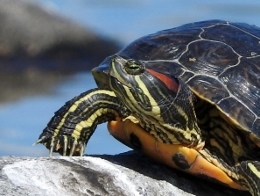
Red-eared Slider
I had a really good walk there, seeing and hearing 28 species of birds. Highlights included a Double-crested Cormorant flying over (new for the trail) and two Broad-winged Hawks calling in the hydro cut area. Eventually I saw them both fly over and disappear into the woods on the north side of the clearing.
There was no water in the pond, as expected, and several shorebirds were foraging in the muck. Unfortunately the sun was right in front of me as I was trying to identify them, and I could only make out one Spotted Sandpiper and eight Killdeer. A Green Heron was also present, tucked behind a rock, and I heard a Swamp Sparrow singing. I continued on my way and, back in the woods where a couple of Eastern Wood-pewees were singing, I startled an accipiter on the ground. It flew off before I could get my binoculars up, but I suspect it was an adult Northern Goshawk – it appeared to be a large, gray bird with pale underparts. I tried to follow it deeper into the woods, but gave up after about fifteen minutes. Other birds seen and heard include Alder Flycatcher, Brown Creeper, Ovenbird, Common Yellowthroat, White-throated Sparrow, and Common Grackle.
From there I headed over to Andrew Haydon Park to check out the mudflats for new shorebird arrivals. Almost as soon as I arrived I noticed this turtle basking on a rock in the western pond. The red mark on its head caught my attention; it was a Red-eared Slider, the second I’ve ever seen, and the first I’ve seen at Andrew Haydon Park.
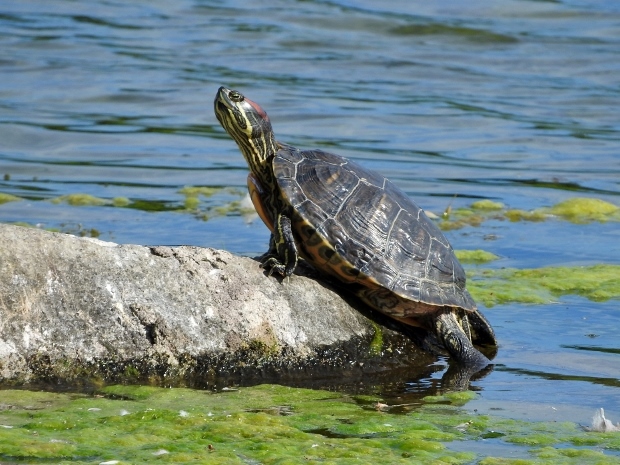
Red-eared Slider
The Red-eared Slider is not native to Ontario, but is unfortunately the most common exotic species of turtle found in Ontario due to human introduction. It looks similar to the native Painted Turtle except for the distinctive red or orange band around the eyes. This species is native to the U.S. and is commonly sold in pet stores. When people later discover that their “pets” can grow to a maximum size of 25 to 33 centimetres and live for more than 30 years in captivity, they often release them into the wild, thinking that they are giving them a good life. What people often do not realize is that the release of non-native species into the wild often has detrimental effects on both their former pets and native turtles. First, Red-eared Sliders are not hardy enough to survive the cold Canadian winter temperatures and usually die off in the first winter after release. Second, they may be carrying bacteria or viruses that are not present in the native environment. The bacteria or virus may then spread to native animals, plants and even humans, which are not well-equipped to deal with resulting infection. Third, non-native turtles may adversely affect native species by out-competing them for food and basking sites, causing native turtle species to become displaced. Finally, non-native turtles may hybridize with closely-related native species, and even predate them in large numbers, resulting in the decline of pure native turtle species. As seven of Ontario’s eight native turtle species are already at risk, it is never a good idea to release pets or non-native species into the wild.
At the mudflats I found a couple of species of shorebirds; six Killdeer were running across the mud, while three Spotted Sandpipers and three Least Sandpipers carefully probed the mud for food. Two Great Egrets and a Caspian Tern flew by, heading downriver toward Mud Lake. Purple Martins were skimming the sky overhead, giving their distinctive calls.
I walked over to the creek at the eastern end of the park, hoping to find some birds in the trees and shrubs there. While it was a bit too early for songbird migration, I saw a good assortment of breeding birds there including Eastern Phoebe, Warbling Vireo, Gray Catbird, American Redstart, Yellow Warbler, and Rose-breasted Grosbeak. The Hooded Merganser family was still present; I found one juvenile sleeping on a log on the eastern pond.

Hooded Merganser
I checked the pond edges for dragonflies, and was happy to see a Dot-tailed Whiteface and a couple of Blue Dashers present. I had brought my net with me this time, and managed to catch a couple of Marsh Bluets in a sunny area near the bridge. A Prince Baskettail was also seen patrolling the area above the eastern lawn.
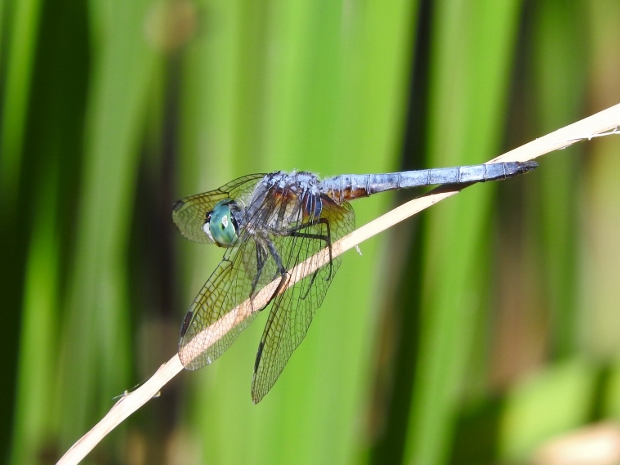
Blue Dasher
There were some fresh Fragrant Water Lilies in bloom in the eastern pond; they were too pretty not to photograph. All of them appeared to be covered with tiny insect larvae.
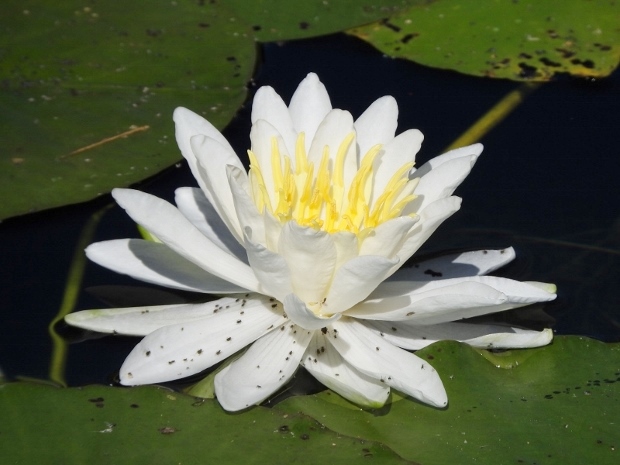
Fragrant Water Lily
After that I headed over to Mud Lake, parking on Howe Street and walking in from the back. As is my usual practice, I stopped by the southern shore of the lake first to look for herons, beavers, muskrats, and turtles. I saw a Great Blue Heron standing in the middle of the lake, and a few turtles basking on the logs close to the shore. I was surprised to see my second Red-eared Slider of the day quite close to where I was standing.
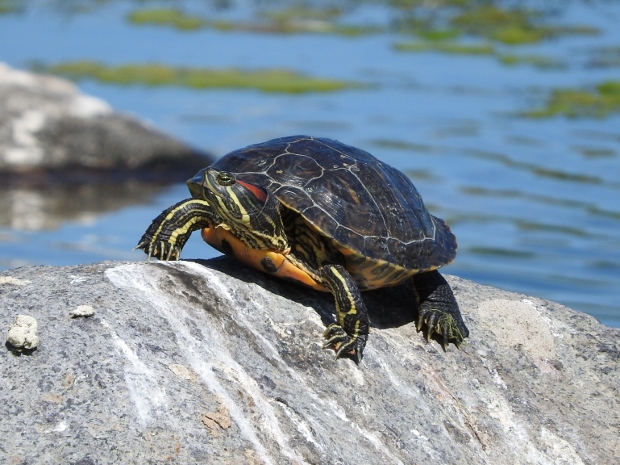
Red-eared Slider
I had seen one in almost the exact same spot in September 2015; given the milder-than-usual winter we’d had last year, was it possible that it had survived? Or was it a different individual? I wondered what the odds were of seeing two different individuals in two different areas on the same day, particularly since I hadn’t seen any others all season long. I hope people aren’t still dumping unwanted turtles in Ottawa’s parks and conservation areas, particularly when other options are available.
I headed up toward the ridge next, cutting through the western sumac field to check for birds. I found several Yellow Warblers, an American Redstart, and a couple of Great Crested Flycatchers. The highlight of my walk was when something buzzed past me and landed on the branch of a shrub close by; I was surprised to see a Cicada there.

Cicada
It was a fairly large insect, and the large eyes set in a triangular-shaped head gave it a distinctly alien appearance. It could be a Dogday Cicada, a common species in the east which emerges annually and is variable in appearance. The larvae feed underground on the roots of pine and oak trees, and adults are thus found in pine woodlands and mixed forests.

Cicada
A Blue Dasher was a nice find in the sumac field, as were a Common Green Darner and Dot-tailed Whiteface.

Blue Dasher
A Gray Catbird flew out onto a branch and started vocalizing when it saw me. It was carrying a beak full of food, so it must have had young nearby.

Gray Catbird
When I emerged onto the main path along the western shore of the pond I spent some time watching the birds on the water. A couple of Mallards and Wood Ducks started swimming toward me, including a group of adorable baby Wood Ducks. They appeared much smaller than some of the other juveniles, indicating that they were a late brood.

Wood Ducks (juveniles)
They were clearly used to being fed, so I threw some peanuts into the water. They and the adults and nearby mallards came rushing in to feed. I got such a kick out of watching them that I didn’t mind giving them all of the food that I had; I am sure they didn’t need it, but I figured it was healthier than the bread people give them.

Wood Duck (juvenile)
One female kept a careful watch on the proceedings from a short distance.

Wood Duck (female)
A few birds much further out on the pond caught my attention. Both were diving under the water repeatedly, and when the closer of the two surfaced I was thrilled to see a Red-necked Grebe! I had known one was spending the summer here, but had forgotten about it until now. This species is more often seen on the river during spring and fall migration, and is very rare during the summer months. Red-necked Grebes normally breed on small inland lakes in northern Ontario, the western provinces and territories, and Alaska. They pass through Ottawa to and from their wintering territories on the Great Lakes and near-shore waters of the northern Atlantic Ocean.

Red-necked Grebe
A smaller Pied-billed Grebe was diving much further out. Pied-billed Grebes are often present at Mud Lake during the summer, as they prefer small, quiet ponds and marshes with thick emergent vegetation. Their shape is quite distinctive, as is the stubby white bill with the black stripe.

Pied-billed Grebe
I took a walk up to the ridge and found more birds including a couple of Eastern Kingbirds, a male Rose-breasted Grosbeak, and a couple of Baltimore Orioles. I also saw a Belted Kingfisher, a Hooded Merganser, and a Spotted Sandpiper in the channel behind the ridge.
It was a great day to be outdoors, and while the Broad-winged Hawks, Red-necked Grebe, and baby Wood Ducks were among my favourite birds, it will be the probably Northern Goshawk that I remember most. Although Trail 26 is not one of my favourite trails, hopefully I can get back there again soon and perhaps have another encounter with my mystery hawk.